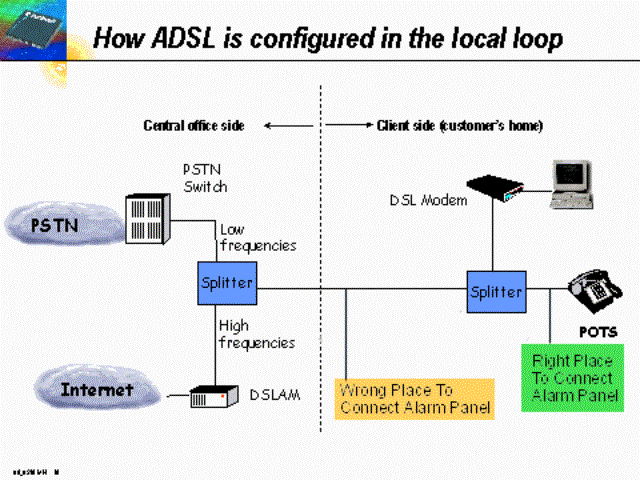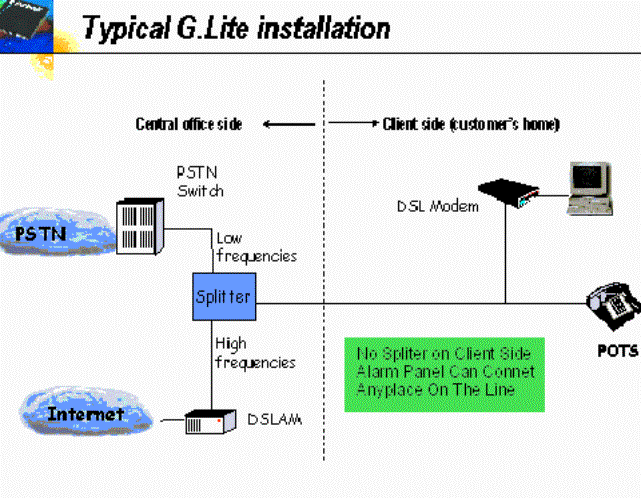Is DSL Interfering With Alarm Systems?
A special report by BizNet OnLine Magazine( www.BizNetonLine.com ) and The Southern California Security Association ( www.SecurityAssociation.com )
|
Is DSL Interfering With Alarm Systems? A special report by BizNet OnLine Magazine( www.BizNetonLine.com ) and The Southern California Security Association ( www.SecurityAssociation.com )
|
If you have a Monitored Burglar or Fire Alarm System then you need to read this. At the April
meeting of The Southern California Security Association several member companies
reported that when their customers added a DSL Internet connection, contact was
lost with the Alarm Panel. And this
can have disastrous results.
Homeowners and Business owners rely on Alarm Systems to help
keep their property safe. One of
the biggest safety features of a Monitored Alarm Panel is that when an emergency
occurs, the System notifies the Central Station ( the folks that monitor the
system) that an event has in fact happened.
The people monitoring the system then take the appropriate action to help
save the Homeowner’s (or Business Owner’s) property.
In the event of a Burglary, the local law enforcement agency is called.
For a fire, the Fire Department is called.
If the system reports a medical emergency, the Monitoring Station can
even send out the paramedics, and call your Doctor along with your family.
Now imagine it’s the middle of the night.
You’re home alone. Something wakes you. You
start to get up, when you fall down. Just
before you black out, you hit your Emergency Alarm Button.
You’re safe. Help is on its way…. Or
is it.
If you had a DSL Line installed, then the Monitoring Facility
may never get your call for help. You’re
just going to lay there and die. No
one knows you’re in need of help.
Why?
Because the company that installed your DSL Line did not know
you had an Alarm System hooked to your phone line. Not knowing to look for the
Alarm Connection to the phone line, the technician hooked up the DSL in the
wrong way, and disabled your Alarm Panel’s ability to call for help.
How can this happen?
To understand how, we must first look at how the Alarm Panel
works with your phone lines and how DSL is connected to your phone line.
Your Alarm Panel.
The phone line your Alarm Panel uses is set up so that the
panel can “seize” the line. What
this means is that when the Panel needs the phone line to contact the Monitoring
Station, it takes control of the phone line.
In doing so it actually disconnects every other phone connected to that
phone line. This is done so that
nothing can interfere with the Panel’s use of the line (like a burglar).
Your telephone wire comes in from the outside connection, from the phone
company. Instead of it going
straight to your phone, because you have an Alarm Panel, the phone line was
re-routed to first go into the Alarm Panel, then out to your phone.
This lets the Panel seize the phone line.
Now add to this the fact that most Alarm Panels are placed out of view
(hidden), and you have a problem waiting to happen when DSL is installed AND the
installer does not know to look for an Alarm Panel.
DSL
A DSL connection is really a very simple thing.
The phone company installs equipment on your phone line that allows one
set of phone wires to work for both your voice needs and your high-speed data
needs. The phone line carries two
signals mixed together. At both
ends an adapter splits the signal into two parts; the Voice part and the Data
part. The voice side works just like your phone line always has.
You can talk on it, fax on it, or even use a Modem on it.
Anything you would use any telephone line for.
The Data side of the line is only for a high-speed data connection.
It is attached at the phone company’s end to a special “switch”; at
your end it connects to a DSL Modem, then to your computer.
This connection is always on. Your
phones work like they always have. There
is only one IMPORTANT thing. All
telephone equipment (like your phones, fax machine and Alarm Panel) must be
connected to the voice side of the DSL connection; the Data is connected to the
Data side. Any Voice Line Device
(like phones, answering machines, fax, and Alarm Panels)connected to the phone
line in the wrong place will not be able to make a connection. It simply will not work. This is where things can go terribly
wrong.
When Things Go Wrong.
If the technician does not know there is an Alarm Panel
attached to the phone line, the installation will probable be done wrong, and
the Alarm Panel will not be hooked up to the Voice side of the line.
This happens because when DSL is installed the phone company hooks your
phone line up to a “Special “ Connection.
The line now coming into your house carries both a Voice and Data
Connection. Anything connected to
your phone lines will now not work. To
make it all work, the installer places a “filter” on your phone line at your
home. Most installers simply pick
the easiest place to install the “filter”.
They look at what is connected to the phone line (phones, fax’s etc.)
and place the ”filter” so that every Voice Line Device (like phones,
answering machines, fax, and Alarm Panels) is on the line after it runs though
the filter. That is, everything but
the Alarm Panel. As the installer
did not know about it, the Panel ended up connected before the “filter” not
after it. Now the Panel can’t
call for help.
How Big Is This Problem?
So fare it has been seen in California.
One thing for sure, it’s not going to be a problem in Europe, as the
Telco’s “Mark” any line that has an Alarm System on it, so the installer
will know about the Alarm when they install the DSL line.
I should also tell you that DSL stands for Digital Subscriber Line, so
the word ‘Line” should not be used after the term DSL.
In this article I am using at most of the public thinks of a DSL
“connection” as a DSL “Line”.
Is Every DSL Installation in the United States Effected?
No. First there
are two types of DSL being installed in the States. The two are Splitter-less DSL known as DSL-G.Light, and ADSL.
It is the ADSL type that can be a problem with Alarm Panels.
See the below illustrations.
(note: information for the illustrations came from : From http://ieee-occs.org/dsl_lite/sld005.htm)
Also the DSL Forum is working to get the word out for ADSL
installers to ask about Alarm Systems. You
can check out the DSL Forum at : http://www.adsl.com/
How Do You Test Your System?
If you have had a DSL line installed, call your Alarm
Company. They can walk you through
testing the Panel. If a
“Communications” failure occurs, it can be fixed. If the system works, everything is O.K.
What’s The Answer?
The solution to this Disaster waiting to happen is to make
sure every consumer knows to tell the installer that there is an Alarm Panel
connected to the phone line, and where the panel is located.
Every Installer need to make sure they not only look for an Alarm Panel,
but ask the owner if there is one installed.
Please get the word out.
DSL and Alarm Panels can get along, but the Installer must know about the
Alarm Panel.
For more information on the Southern California Security
Association : www.SecurityAssociation.com
For More information on DSL check out the DSL Forums Web Site : http://www.adsl.com
Illustration of DSL installation with “Splitter”.
Also known as ADSL. Connect


Send mail to editor@biznetonline.com with questions or comments about this web
site.
Copyright © 1997 ~BizNet OnLine Magazine
Last modified: November 08, 2002